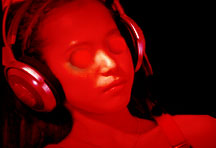دورآگاهی
دورآگاهی یا تلهپاتی (از عبارات یونانی τῆλε، تله به معنی "دور"، و πάθος، پاتوس یا -پاتیا به معنی "احساس، اشتیاق، ادراک، رنج، تجربه") است، که ادعا شده میتواند انتقال متناوب اطلاعات از یک شخص به شخص دیگر بدون استفاده از کانالهای حسی شناخته شده یعنی بدون استفاده از حواس پنجگانه انسانی یا تعامل بدنی و فیزیکی انتقال اطلاعات را انجام دهد.

این اصطلاح اولین بار در سال ۱۸۸۲ توسط دانشمند کلاسیک فردریک دبلیو. ایچ. مایرز بنیانگذار جامعه تحقیقات روان (SPR) ابداع شد[۱] و محبوبیت بیشتری نسبت به عبارت قبلی انتقال فکر داشت.[۱][۲]
آزمایشهای تلهپاتی از نظر تاریخی به دلیل عدم کنترل مناسب و فقدان تکرارپذیری مورد انتقاد قرار گرفتهاست. هیچ مدرک و دلیل قانعکنندهای مبنی بر وجود توانایی دورآگاهی وجود ندارد و جامعهٔ علمی بهطور کلی موضوع را شبهعلمی میدانند.[۳][۴][۵][۶]
بازخورد علمی
ویرایشآزمایشهای مختلفی برای نشان دادن تلهپاتی انجام شدهاست، اما هیچ مدرک علمی مبنی بر وجود این توانایی وجود ندارد.[۷][۸][۹][۱۰] هیئتی به سفارش شورای تحقیقات ملی ایالات متحده برای بررسی ادعاهای فراطبیعی به این نتیجه رسید، که "علیرغم سابقهٔ ۱۳۰ سالهٔ تحقیقات علمی در مورد چنین مواردی، کمیتهٔ ما هیچ توجیه علمی برای وجود پدیدههایی مانند ادراک فراحسی، تلهپاتی ذهنی یا تمرینات "اثر ذهن بر ماده"و … نیافتهاست. ارزیابی تعداد زیادی از بهترین شواهد موجود، به راحتی ادعای وجود این پدیدهها را تأیید نمیکند. جامعه علمی رشتهٔ پاراسایکولوژی را یک شبهعلم میداند.[۱۱][۱۲][۱۳][۱۴] هیچ مکانیسم شناخته شدهای برای تلهپاتی وجود ندارد.[۱۵] ماریو بانژ، فیلسوف و فیزیکدان نوشتهاست که تلهپاتی با قوانین علم مغایرت دارد، و این ادعا که «سیگنالها میتوانند از طریق فضا منتقل شوند بدون اینکه با فاصله کمرنگ یا ضعیف شوند، با فیزیک مغایرت دارد».
جستارهای وابسته
ویرایشکتابشناسی
ویرایش- تلهپاتی، ترجمهٔ یاسین قاسمی بجد، انتشارات پل
- تلهپاتی در ۳۰ روز، ترجمهٔ یاسین قاسمی بجد، انتشارات پل
پانویس
ویرایش- ↑ ۱٫۰ ۱٫۱ «telepathy - The Skeptic's Dictionary - Skepdic.com». skepdic.com. دریافتشده در ۲۰۲۱-۰۵-۱۳.
- ↑ «Glossary of Psi (Parapsychological) Terms (S-Z)». web.archive.org. ۲۰۰۶-۰۹-۲۷. بایگانیشده از اصلی در ۲۷ سپتامبر ۲۰۰۶. دریافتشده در ۲۰۲۱-۰۵-۱۳.
- ↑ Planer، Felix (۱۹۸۰). Superstition. Cassell. صص. ۲۱۸. شابک ۰-۳۰۴-۳۰۶۹۱-۶.
- ↑ Dalkvist, Jan (1994-01-01). Telepathic group communication of emotions as a function of belief in telepathy (به انگلیسی). Dept. of Psychology, Stockholm University.
- ↑ Drees, Willem B. (1998-11-12). Religion, Science and Naturalism (به انگلیسی). Cambridge University Press.
- ↑ Spencer، Rathus (۲۰۱۱). Psychology: Concepts and Connections. Cengage Learning. صص. ۱۴۳. شابک ۹۷۸-۱۱۱۱۳۴۴۸۵۶.
- ↑ Jan Dalkvist (1994). Telepathic Group Communication of Emotions as a Function of Belief in Telepathy. Dept. of Psychology, Stockholm University. Retrieved 5 October 2011.
Within the scientific community however, the claim that psi anomalies exist or may exist is in general regarded with skepticism. One reason for this difference between the scientist and the non scientist is that the former relies on his own experiences and anecdotal reports of psi phenomena, whereas the scientist at least officially requires replicable results from well controlled experiments to believe in such phenomena—results which according to the prevailing view among scientists, do not exist.
- ↑ Simon Hoggart, Mike Hutchinson. (1995). Bizarre Beliefs. Richard Cohen Books. p. 145. شابک ۹۷۸−۱۵۷۳۹۲۱۵۶۵ "The trouble is that the history of research into psi is littered with failed experiments, ambiguous experiments, and experiments which are claimed as great successes but are quickly rejected by conventional scientists. There has also been some spectacular cheating."
- ↑ Robert Cogan. (1998). Critical Thinking: Step by Step. University Press of America. p. 227. شابک ۹۷۸−۰۷۶۱۸۱۰۶۷۴ "When an experiment can't be repeated and get the same result, this tends to show that the result was due to some error in experimental procedure, rather than some real causal process. ESP experiments simply have not turned up any repeatable paranormal phenomena."
- ↑ Terence Hines. (2003). Pseudoscience and the Paranormal. Prometheus Books. p. 144. شابک ۹۷۸−۱۵۷۳۹۲۹۷۹۰ "It is important to realize that, in one hundred years of parapsychological investigations, there has never been a single adequate demonstration of the reality of any psi phenomenon."
- ↑ Daisie Radner, Michael Radner. (1982). Science and Unreason. Wadsworth. pp. 38-66. شابک ۰−۵۳۴−۰۱۱۵۳−۵
- ↑ Bunge, Mario (1987). "Why Parapsychology Cannot Become a Science". Behavioral and Brain Sciences. 10 (4): 576–577. doi:10.1017/s0140525x00054595.
- ↑ Michael W. Friedlander. (1998). At the Fringes of Science. Westview Press. p. 119. شابک ۰−۸۱۳۳−۲۲۰۰−۶ "Parapsychology has failed to gain general scientific acceptance even for its improved methods and claimed successes, and it is still treated with a lopsided ambivalence among the scientific community. Most scientists write it off as pseudoscience unworthy of their time."
- ↑ Massimo Pigliucci, Maarten Boudry. (2013). Philosophy of Pseudoscience: Reconsidering the Demarcation Problem. University Of Chicago Press p. 158. شابک ۹۷۸−۰۲۲۶۰۵۱۹۶۳ "Many observers refer to the field as a "pseudoscience". When mainstream scientists say that the field of parapsychology is not scientific, they mean that no satisfying naturalistic cause-and-effect explanation for these supposed effects has yet been proposed and that the field's experiments cannot be consistently replicated."
- ↑ Charles M. Wynn, Arthur W. Wiggins. (2001). Quantum Leaps in the Wrong Direction: Where Real Science Ends...and Pseudoscience Begins. Joseph Henry Press. p. 165. شابک ۹۷۸−۰۳۰۹۰۷۳۰۹۷ "One of the reasons scientists have difficulty believing that psi effects are real is that there is no known mechanism by which they could occur. PK action-at-a-distance would presumably employ an action-at-a-distance force that is as yet unknown to science... Similarly, there is no known sense (stimulation and receptor) by which thoughts could travel from one person to another by which the mind could project itself elsewhere in the present, future, or past."
منابع
ویرایش- واژههای مصوب فرهنگستان زبان و ادب فارسی
- لغتنامه دهخدا
- مشارکتکنندگان ویکیپدیا. «Telepathy». در دانشنامهٔ ویکیپدیای انگلیسی، بازبینیشده در ۲۹ ژانویهٔ ۲۰۲۱.